| Previous | Contents | Index |
In addition to understanding the RTR run-time and system management environments, you must also understand the RTR applications environment and the implications of that environment on your implementation. This section provides information on requirements that transaction processing applications must take into account and deal with effectively. It also cites rules to follow that can help prevent your application from violating the rules for ensuring that your transactions are ACID compliant. The requirements and rules complement each other and sometimes repeat a similar concept. Your application must take both into account.
Applications written to operate in the RTR environment should adhere to the following rules:
RTR expects server applications to be transaction aware; an application must be able to roll back an appropriate amount of work when asked. Furthermore, to preserve transaction integrity, rollback must be all or nothing. Each transaction incurs some overhead, and the application must be prepared to deal with failures and concomitant rollback gracefully. When designing your client and server applications, note the outcome of transactions. Transactional applications often store data in variables that pertain to the operation taking place outside the control of RTR. Depending on the outcome of the RTR transaction, the values of these variables may need to be adjusted. RTR guarantees delivery of messages (usually to a database), but RTR does not know about any data not passed through RTR.
The rule is: Code your application to preserve transaction integrity through failures.
The client and server applications must not exchange any data that makes sense on only one node in the configuration. Such data can include, for example, a memory reference pointer, whose purpose is to allow the client to reference this context in a later transaction, indexes into files, node names, or database record numbers. These values only make sense on the machine on which they were generated. If your application sends data to another machine, that machine will not be able to interpret the data correctly. Furthermore, data cannot be shared across servers, transaction controllers, or channels.
The rule is: How you track state must be meaningful on all nodes where your application runs.
Transactions are assumed to contain all the context information required to be successfully executed. An RTR transaction is assumed to be independent of time of processing. For example, in a shadow environment, if the secondary server cannot credit an account because it is past midnight, but the transaction has already been successfully committed on the primary server, this would cause an inconsistency between the primary and secondary databases. Or, in another example, Transaction B cannot rely on the fact that Transaction A performed some operation before it.
Make no assumptions about the amount of time that will occur between transactions, and avoid using a transaction to establish a session with a server application that can time out. Such a timeout might occur in a client application that logs onto a server application that sets a timer to determine when to log the client off. If a crash occurs after a successful logon, subsequent transactions may fail because the logon session is no longer valid.
The rule is: If you have operations that must not be shadowed, identify them and exclude them from your application. Furthermore, do not keep a state that can become stale over time.
In your application, you can define transactions as independent with the C++ API, using the SetIndependentTransaction method in your transaction controller AcceptTransaction or SendApplicationMessage calls. Using the C API, you use the independent transaction flag in your rtr_accept_tx or rtr_reply_to_client calls.
For more information on the independent transaction methods in the RTRServerTransactionController class, see the RTR C++ Foundation Classes manual. For more information on the independent transaction flag and the different uses of these calls, see the RTR C Application Programmer's Reference Manual.
Shadow server use is aimed at keeping two identical copies of the database synchronized. For example, Figure 3-1 illustrates a configuration with a router serving two backends to two shadow databases. The second router is for router failover.
Figure 3-1 Transactional Shadow Servers
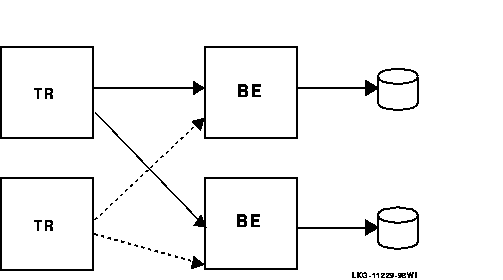
If an update of a copy triggers the update of a third common database, the application must determine whether it is running as a primary or a secondary, and only perform an update if it is the primary. Otherwise, there can be complex failure scenarios where duplication can occur.
For example, RTR has no way to determine if a transaction being shadowed is a one-time-only transaction, such as a bookstore debiting your credit card for the purchase of a book. If this transaction is processed on the primary node and the processed data fed to a third common database, and the transaction is later processed on the secondary node, your account would incorrectly be double charged. The application must handle this situation correctly.
The rule is: Design your application to deal correctly with transactions, such as debiting a credit card or bank account, that must never be performed more than once.
Figure 3-2 shows a configuration with two shadow servers and a third, independent server for a third, common database. This is not a configuration recommended for use with RTR without application software that deals with the kind of failure situation described above. Another method is to decouple the shadow message from the other branch.
Figure 3-2 Shadow Servers and Third Common Database (not recommended)
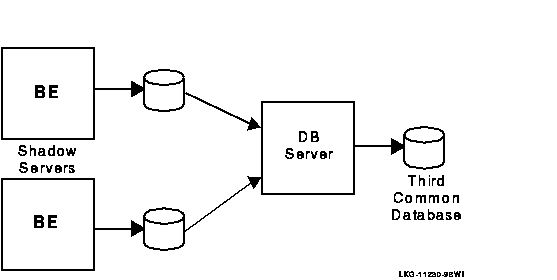
When updating a single resource through multiple paths, the recommended method is to use the RTR standby functionality.
All information required to process a transaction from the perspective of the server application should be contained within the transaction message. For example, if the application required a user-ID established earlier to successfully execute the transaction, the user-ID should be included in the transaction message.
The rule is: Construct complete transaction messages within your application.
While a server application is processing a transaction, and particularly before it "accepts" the transaction, it must ensure that all shared resources accessed by that transaction are locked. Failure to do so can cause unpredictable results in shadowing or recovery.
The rule is: Lock shared resources while processing each transaction.
To ensure that your application deals with transactions correctly, its transactions must be:
For the atomic attribute, the result of a transaction is all or nothing, that is, either totally committed or totally rolled back. To ensure atomicity, do not use a data manager that cannot roll back its updates on request. All standard data managers or database management systems have the atomicity attribute. However, in some cases, when interfacing to an external legacy system, a flat-file system, or an in-memory database, a transaction may not be atomic.
For example, a client application may believe that a transaction has been rejected, but the database server does not. With a database manager that can make this mistake, the application itself must be able to generate a compensating transaction to roll back the update.
Data managers that do not use XA/DTC, DECdtm or Microsoft DTC to integrate with RTR using XA or DECdtm must be programmed to handle rtr_mt_msg1_uncertain messages .
For example, to illustrate the atomicity rules, Figure 3-3 shows the uncertain interval in a transaction sequence that the application program must be aware of and take into account, by performing appropriate rollback.
Figure 3-3 Uncertain Interval for Transactions
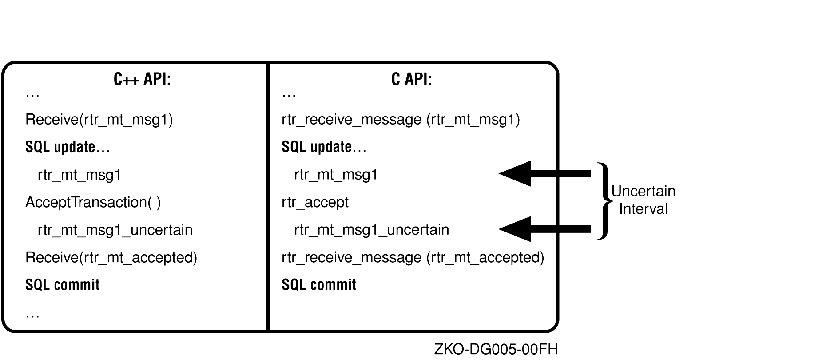
If there is a crash before the AcceptTransaction method ( rtr_accept_tx statement for the C API) is executed, on recovery, the transaction is replayed as rtr_mt_msg1 because the database will have rolled back the prior transaction instance. However, if there is a crash after the AcceptTransaction method or rtr_accept_tx statement is executed, on recovery, the transaction is replayed as rtr_mt_msg1_uncertain because RTR does not know the status of the prior transaction instance. Your application must understand the implications of such failures and deal with them appropriately.
A transaction either creates a new and valid state of data, or, if any failure occurs, returns all data to its state as it was before the start of the transaction. This is called consistency.
Several rules must be considered to ensure consistency:
The changes to shared resources that a transaction causes do not become visible outside the transaction until the transaction commits. This makes transactions serializable. To ensure isolation:
Figure 3-4 Concurrent Server Commit Grouping
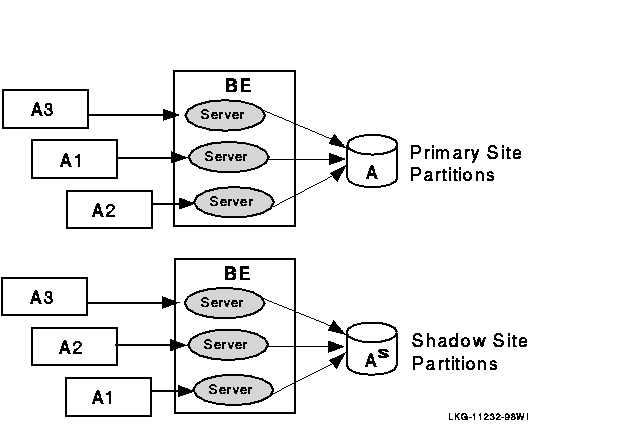
RTR commit grouping allows independent transactions to be scheduled together on the shadow secondary.
For a transaction to be durable, the changes caused by transaction commitment must survive subsequent system and media failure. Thus transactions are both persistent and stable.
For example, your bank deposit is durable if, once the transaction is complete, your account balance reflects what you have deposited.
The durability rule is:
If there are dependencies between separate RTR transactions, these should be considered carefully because the locking mechanisms of resource managers can cause unexpected behavior. These issues around locking mechanisms occur only if there is more than one server for the same partition.
For example, consider the case where there is a transaction T1 which inserts a record in the database and a subsequent transaction T2 which uses that record to make another update. If the partition has been configured with concurrent servers, it can happen that the update transaction T2 which has been given to a free server will begin executing and reach the database before the insert operation issued by transaction T1 has completed the commit process. In this scenario, the inserted record is not yet visible to the update transaction T2 because the commit is not yet complete. This will cause transaction T2 to fail. However, if the database table being updated is locked for the duration of the insert, transaction T2 will block (wait) until the insert has committed and there will be no possibility of transaction T2 overtaking transaction T1.
In another example, the first transaction T1 makes an update to the table and a second transaction T2 uses the updated value in its transaction. If the resource manager does not lock the row being accessed by transaction T1 right at the start of the update, that row can be queried by the second transaction T2 which has started on a concurrent server. However, transaction T2 will in this case be working with the old and not the updated value that was the result of T1. To prevent such unexpected and potentially undesirable behavior, check the locking mechanisms of the resource managers being used before using concurrent servers.
RTR provides client applications the option to specify a transaction timeout , but has no provision for server applications to specify a timeout on transaction duration. If there is a scarcity of server application processes, all other client transactions remain queued. If these transactions have also specified timeouts, they are aborted by RTR (assuming that the timeout value is less than 2 minutes).
To avoid this problem, the application designer has two choices:
The first (and easier) option is to use concurrent server processes. This allows transaction requests to be serviced by other free servers, even if one server is occupied by such a transaction that is taking a long time to disappear. The second option is to design the server application so that it can abort the transaction independently.
There are three cases where this use of concurrent servers is not ideal. First, there is an implicit assumption about how many such lingering transactions might remain on the system. In the worst case, this could exceed or equal the number of client processes. But having so many concurrent server processes to cater to this contingency is wasteful of system resources. Second, use of concurrent servers is beneficial when the servers do not need to access a common resource. For instance, if all these servers needed to update the same record in the database, they would simply be waiting on a lock taken by the first server. Additional servers do not resolve this issue. Third, it must make business sense to have additional servers. For example, if transactions must be executed in the exact order in which they entered the system, concurrent servers may introduce sequencing problems.
Take the example of the order matcher in a stock trading application. Business rules may dictate that orders be matched on a first-come, first- matched basis; using concurrent servers would negate this rule.
The second option is to let the server application process administer its own timeout and abort the transaction when it sees no activity on its input stream.
To ensure that transactions are fully executed and that the database is consistent, RTR uses the two-phase commit process for committing a transaction. The two-phase commit process has both a prepare phase and a commit phase. Transactions must reach the commit phase before they are hardened in the database.
The two-phase commit mechanism is initiated by the client when it executes a call to RTR that declares that the client has accepted the transaction. The servers participating in the transaction are then asked to be prepared to accept or roll back the transaction, based on a subsequent request.
Transactions are prepared before being committed by accept processing. Table 3-1 lists backend transaction states that represent the steps in the prepare phase.
| Phase | State | Meaning |
|---|---|---|
| Phase 0 | WAITING | Waiting for a server to become free. |
| RECEIVING | Processing client messages. | |
| Phase 1 | VREQ | Vote of server requested. |
| VOTED | Server has voted and awaits final transaction status. | |
| Phase 2 | COMMIT | Final status of a committed transaction delivered to server. |
| ABORT | Final status of an aborted transaction delivered to server. |
The RTR frontend sees several transaction states during accept processing. Table 3-2 lists frontend transaction states that represent the steps in the prepare phase.
| State | Meaning |
|---|---|
| SENDING | Processing, not ready to accept. |
| VOTING | Accept processing in process; frontend has issued an rtr_accept_tx call, but the transaction has not been acknowledged. |
| DONE | Transaction is complete, either accepted or rejected. |
Implementation details are shown in the separate chapters for the RTR APIs.
An RTR transaction can be part of a transaction that is coordinated by a parent transaction manager such as RTR itself, or Tuxedo, or MS DTC. RTR lets transactions be embedded within other transactions; such transactions are called nested transactions or subtransactions. A nested transaction is considered indivisible within its enclosing transaction, typically coordinated by a parent transaction manager.
A transaction that is not nested is called a top-level transaction. A nested transaction is a child of its parent (enclosing) transaction . A parent may have several children who are siblings ; ancestor and descendent relationships apply. A top-level transaction and its descendants are collectively known as a transaction family or a family .
A nested transaction must be strictly nested within its enclosing transaction; it must be completed (committed or aborted) before the enclosing transaction can complete. If the enclosing transaction aborts, all effects of the nested transaction are also undone.
A transaction can create several child transactions; the parent transaction performs no work until all child transactions are complete. A transaction cannot, however, observe the effects of a sibling transaction until that sibling completes.
Nested transactions isolate the effect of failures from the enclosing transaction and from other concurrent transactions. A nested transaction that has not completed can abort without causing its parent transaction to abort.
Committed nested transactions are durable (permanent) only with respect to certain other transactions: a committed child is permanent with respect to its parent. To stop a committed child, the parent transaction is stopped. The child is said to be committed with respect to its parent, or with respect to its siblings. Every transaction is committed with respect to itself and its descendants. To abort a committed nested transaction, all of its committed-with-respect-to transactions must be aborted.
With RTR, client/server messaging enables the application to send:
With RTR, client and server applications communicate by exchanging messages in a transaction dialog. Transactional messages are grouped in a unit of work called a transaction. RTR takes ownership of a message when called by the application.
A transaction is a group of logically connected messages exchanged in a transaction dialog. Each dialog forms a transaction in which all participants have the opportunity to accept or reject the transaction. A transaction either commits or aborts. When the transaction is complete, all participants are informed of the transaction's completion status. The transaction succeeds if all participants accept it, but fails if even one participant rejects it.
In the context of a transaction, an RTR client application sends one or more messages to the server application, which responds with zero or more replies to the client application. Client messages can be grouped to form a transaction. All work within a transaction is either fully completed or all work is undone. This ensures transaction integrity from client initiation to database commit with the cooperation of the server application.
For example, say you want to take $20 from your checking account and add it to your savings account. With an application using RTR you are assured that this entire transaction is completed; you will not be left at the point where you have taken $20 from your checking account but it has not yet been deposited in your savings account. This feature of RTR is transactional integrity, illustrated in Figure 3-5.
Figure 3-5 Transactional Messaging

The transactional message is either all or nothing for everything enclosed in brackets [ ] in Figure 3-5.
An RTR client application sends one or more messages to one or more server applications and receives zero or more responses from one or more server applications. For example:
RTR generates a unique identifier, the transaction ID or TID, for each transaction. The client can inject also its own TID into RTR. Doing so will make RTR treat the transaction as a nested transaction.
Figure 3-6 illustrates frontend/backend interaction with pseudo- code for transactions and shows transaction brackets. The transaction brackets show the steps in completing all parts of a transaction, working from left to right and top to bottom. The transaction (txn) is initiated at "Start txn" at the frontend, and completed after the "Commit txn" step on the backend. The transaction ID is encoded to ensure its uniqueness throughout the entire distributed system. In the prepare phase on the server, the application should lock the relevant database (db) records. The commit of a transaction hardens the commit to the database. The rtr_start_tx message specifies the characteristics of the transaction. RTR identifies the server based on key information in the transaction.
Figure 3-6 Transactional Messaging Interaction
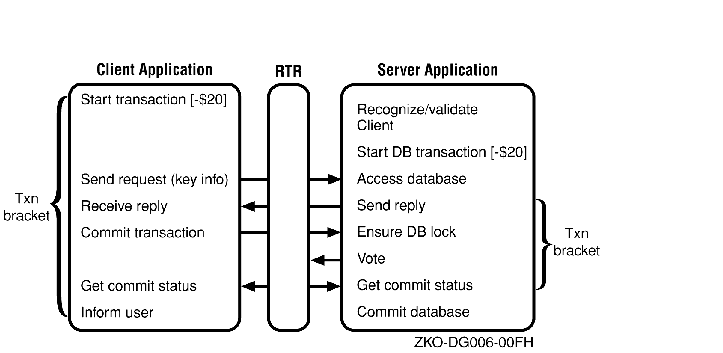
| Previous | Next | Contents | Index |